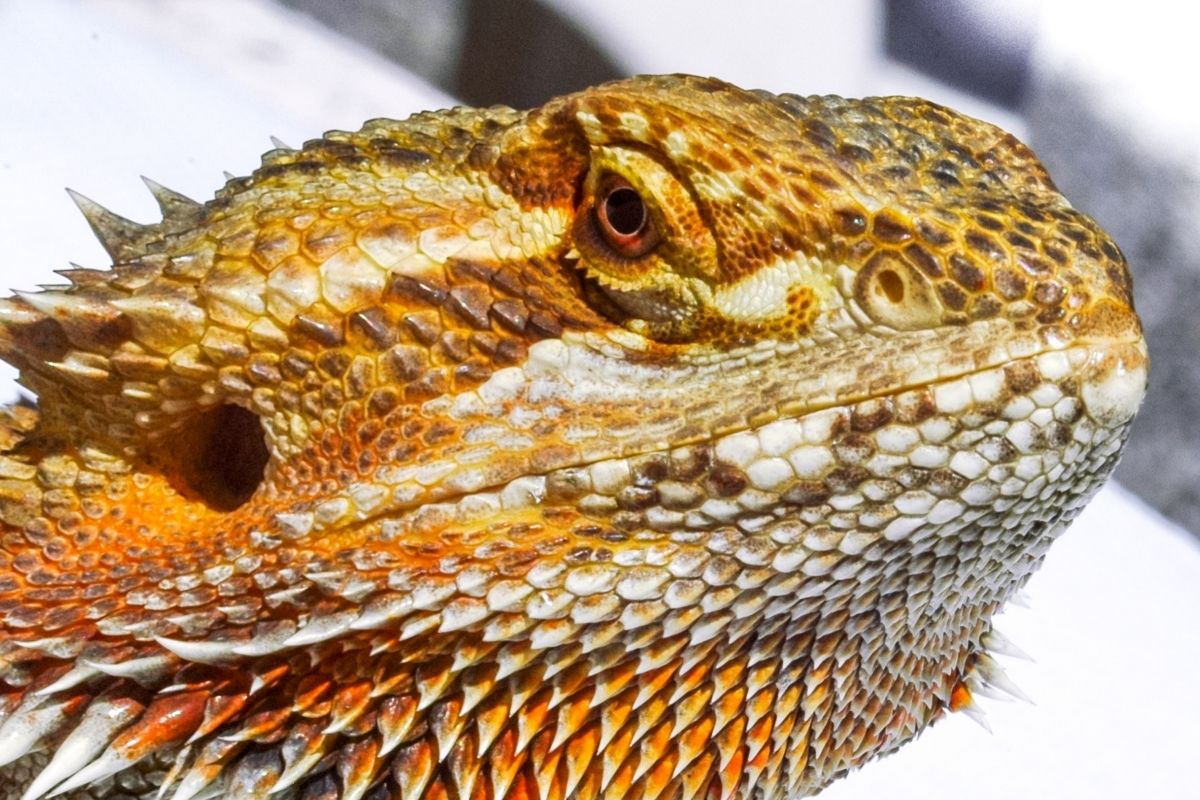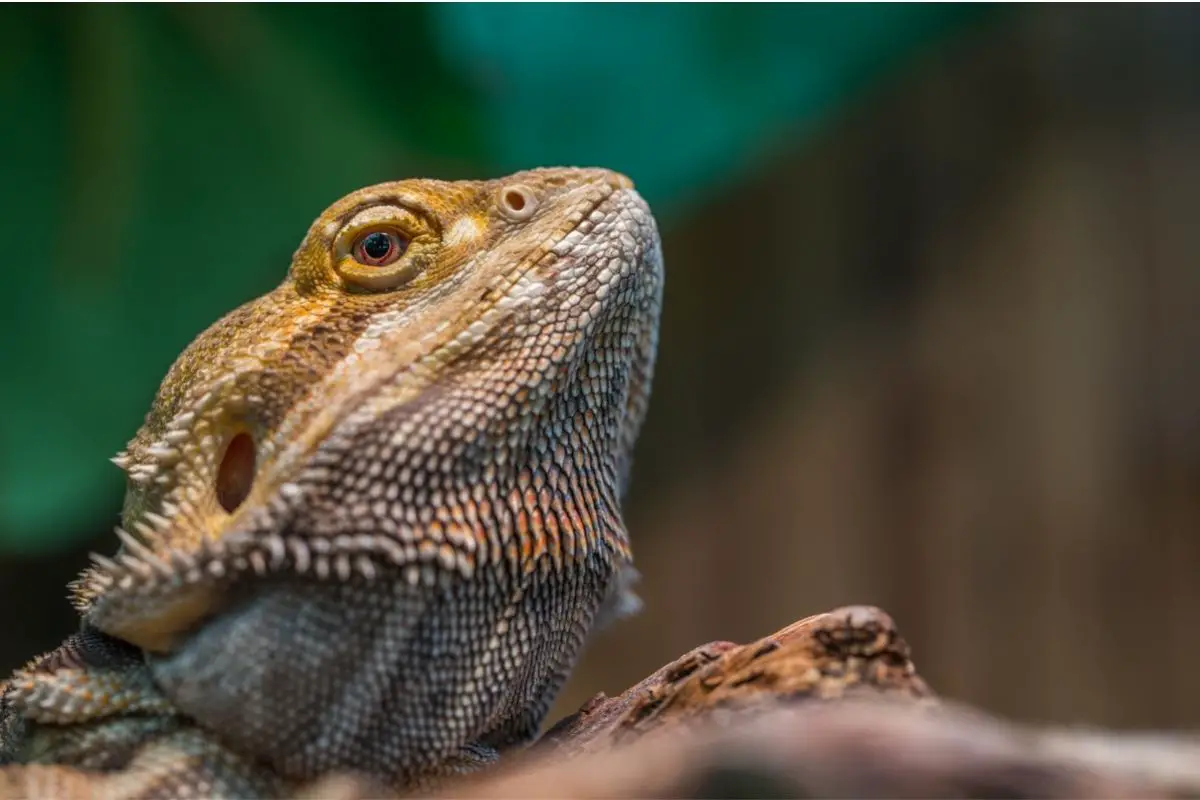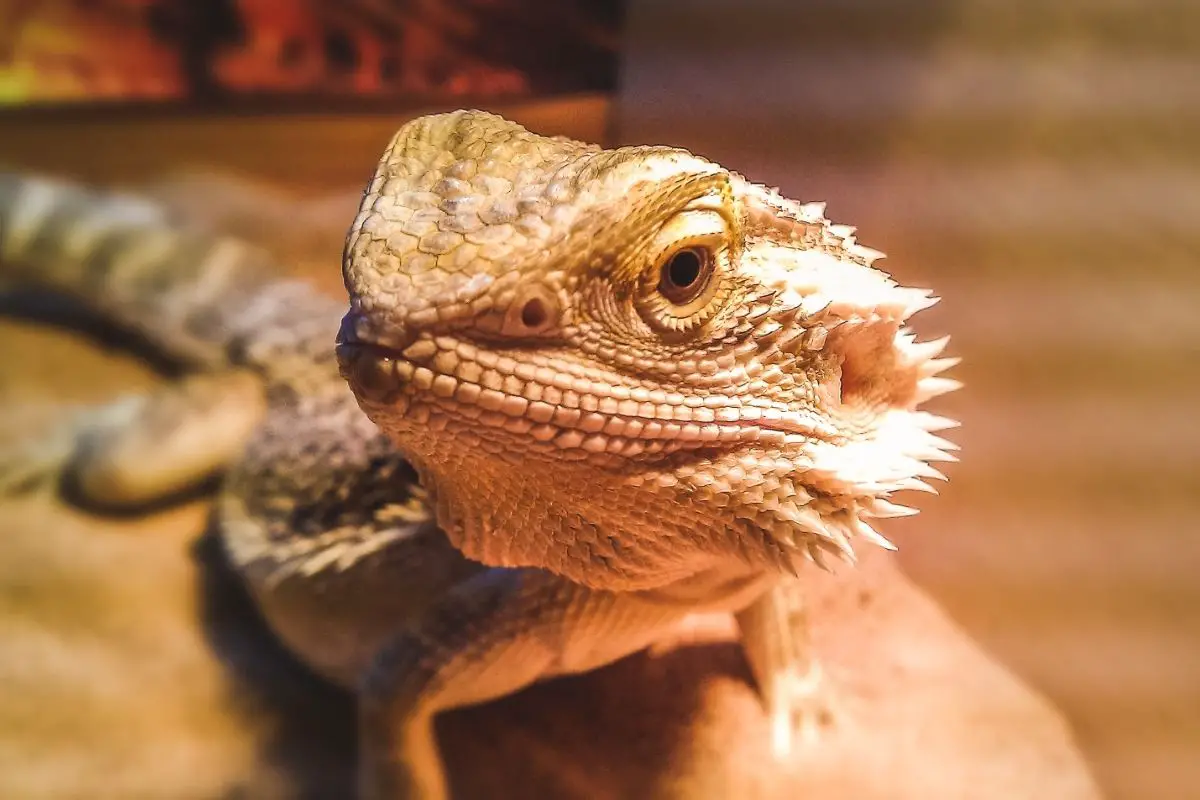Did you know that there are many types of bearded dragons?
One bearded dragon type, or ‘morph’, is the giant German Bearded dragon.

It can be tricky to tell the difference between a regular bearded dragon and a giant German morph, but if you have the latter, it’s very important to know this.
This is because giant German bearded dragons have slightly different care requirements than other dragons, so you need to know what kind of bearded dragon you own in order to provide the best care.
Today, we will be sharing 7 ways you can tell whether your bearded dragon is a giant German morph.
We’ll also be explaining how to care for this type of bearded dragon and how long you can expect yours to live.
Identifying A Giant German Bearded Dragon
Admittedly, figuring out whether you have a giant German bearded dragon is not always easy, but here at 7 ways to tell:
Size/Weight
As you might expect, given its name, the giant German bearded dragon is bigger and weighs more than your average bearded dragon.
Giant German bearded dragons are roughly 50% larger and heavier than other morphs.
Where a regular bearded dragon might weigh between 400 and 500 grams, a giant German bearded dragon can weigh up to 1,000 grams (1 kilogram).
The difference in length from head to tail is not quite as large as the average weight difference, but it’s still significant.
Usually, bearded dragons do not grow longer than 24 inches in length, but if you have a giant German bearded dragon, it might grow up to 35 inches long!
Rate Of Growth
Not only are giant German bearded dragons significantly larger than their inland bearded dragon counterparts, but they grow at a faster rate.
The growth rate for bearded dragons is generally pretty fast, with hatchlings growing extremely quickly during the first 6 months in particular.
Regular bearded dragons usually measure 3 inches in length when they hatch, but giant German bearded dragons emerge from their eggs at roughly 6 inches long.
By the 6-month mark, giant German bearded dragons frequently measure 21 inches, while a regular dragon would typically only measure 14 inches at this point.
Eye Color
One subtle but key difference between regular inland bearded dragons and giant German bearded dragons is eye color.
It is important to know that this is not necessarily a reliable characteristic.
Eye color can vary even within bearded dragon morphs, so just because your dragon has eyes of a certain color, it does not mean it is definitely a specific species.
However, combined with other factors from this list, you might be able to use eye color to identify your morph.
It has been noted that giant German bearded dragons tend to have a silvery or gold eye color, whereas regular bearded dragons typically have brown or yellow eyes.
Obviously, the distinction between yellow and gold can be quite difficult to pinpoint, which is part of the reason why we don’t recommend using this characteristic alone to identify your bearded dragon.
Body Proportions

We’ve established that giant German bearded dragons are larger and heavier than regular adult bearded dragons and that they grow at a faster rate.
However, another useful way of telling bearded dragon morphs apart is to look at their bodily proportions.
Although giant German bearded dragons have long, robust bodies, their heads are fairly small in comparison.
It should be noted that this does not mean that giant German bearded dragons actually have small heads.
If you compare the head of an adult giant German bearded dragon to that of a regular bearded dragon, you’ll probably find that the giant German morph’s head is still larger.
It’s just that their bodies are so large that their heads look proportionally smaller.
This is one of the main physical indicators a bearded dragon owner can use to determine whether their dragon is a giant German morph.
Blood Test
The morph of your bearded dragon can be identified through a blood test.
Your exotic pet vet may be able to perform a blood test on your dragon for you and then send the sample to a laboratory.
At the laboratory, the blood sample can then be analyzed and the results will show whether your bearded dragon is a giant German morph or not.
Please bear in mind that it is not always easy to obtain this type of blood test.
Giant German bearded dragons are not very common and when there is some giant German blood, it is often not 100% pure, making obtaining a clear result via testing trickier.
With that being said, experienced exotic pet vets may offer the service or be able to refer you to someone who will perform the test.
If you look online, you may also be able to find a company that you can send a blood sample to for results, but make sure that it’s a reputable company with positive testimonials beforehand.
Genetic Tracing
If you’re really determined to find out what kind of bearded dragon you have, you could go down the route of genetic tracing.
This is more difficult than some other factors on our list, but if you are able to get in contact with the breeder from whom you purchased your bearded dragon, you can get a good indication of whether your bearded dragon is a giant German morph.
Basically, the gene that separates giant German bearded dragons from other bearded dragons is recessive, meaning that it may not always be passed on from parent to offspring.
However, if your bearded dragon’s parents have the gene, there is a good chance that your dragon will, too.
Obviously, the only person who is likely to have or be able to obtain this information is the breeder of your dragon, so get in touch if you need your dragon’s genetic profile.
Again, remember not to assume that just because your bearded dragon’s parents have this gene, your dragon must be a giant German morph.
Because the gene is recessive, there is a chance that it hasn’t been passed on.
Nevertheless, if your dragon otherwise matches the profile of a giant German bearded dragon, a genetic match from the parents is a promising sign.
Egg Laying
Female bearded dragons lay fairly large clutches of eggs.
It is quite typical for an inland bearded dragon to lay 14 to 16 eggs at a time.
Sometimes, clutches can consist of an impressive 20 eggs.
However, that’s nothing compared to the size of the clutches that female giant German bearded dragons can lay!
Giant German bearded dragons have been known to lay clutches of 60 eggs once they reach sexual maturity.
This is partly why this type of bearded dragon is so popular with breeders, because they can produce a great many baby bearded dragons.
Giant German Bearded Dragon Care Requirements
Once you have determined that your dragon is, in fact, a giant German morph, you will need to make some adjustments to your care routine.
This is because giant German bearded dragons have different needs to your average dragon.
Living Environment
Because giant German bearded dragons are significantly larger than their inland counterparts, they need bigger enclosures.
You should ensure that your dragon has enough room to run around comfortably and get as much exercise as it needs.
Remember that your enclosure will also need to leave room for the proper heat lamp setup and a basking spot.
Dietary Requirements

Another implication of the giant German bearded dragon’s larger size is that this morph also consumes more food than other morphs.
In terms of nutrients, your giant German bearded dragon will need the same things as a regular dragon, just in larger quantities.
An easy way to remember your dragon’s nutritional needs is the 80/20 rule: 80% green vegetables, 20% insect protein.
Be aware that your giant German morph will probably have an increased appetite for insects.
While it won’t do any harm to give your dragon a few extra insects now and again as a treat, don’t overfeed on protein and allow your beardy to neglect its greens.
This can lead to malnourishment and eventual health complications down the line.
It is especially important to feed your giant German bearded dragon correctly before it reaches 6 months of age because baby bearded dragons can suffer from stunted growth if they are malnourished early in life.
You can find suitable insect mixes for your bearded dragon at most pet stores that cater to exotic animals.
Health Care
Many people assume that larger dragons like the giant German bearded dragon are more robust in terms of health, but that doesn’t mean you should neglect proper care or dismiss the possibility of illness.
While it’s true that giant German bearded dragons do seem to get sick less often, there are some complications and conditions you need to watch out for.
Some studies have shown that giant German morphs may be more prone to parasitic infections than other bearded dragons.
This is probably not because they are actually more susceptible to this kind of infection, but simply because they consume larger quantities of food, which means that they are exposed to more parasites.
If you have a female giant German bearded dragon, and you intend to breed her, you will need to consider her breeding health once she reaches sexual maturity.
This is because giant German bearded dragons lay larger clutches of eggs, and therefore, can experience some complications that aren’t as common in other morphs.
For example, giant German morphs are prone to a complication called egg binding, where the eggs get stuck while the female is trying to lay them.
This is especially common when the enclosure does not have a suitable area for egg laying because the female will hold the eggs inside her.
Large clutches can also result in a prolapse of the cloaca due to the straining that is necessary to pass all the eggs.
Additionally, because of the larger size of the giant German bearded dragon, females of this species will produce huge amounts of hormones when breeding.
These hormones can cause their femoral pores to become blocked, and they will need cleaning.
Average Life Expectancy For Giant German Bearded Dragons
Giant German bearded dragons may be larger than inland bearded dragons, but that doesn’t mean that they have a drastically different life expectancy, contrary to popular belief.
You can expect your giant German bearded dragon to live for about as long as your average bearded dragon (between 10 and 15 years).
It must be said, though, that larger dragons like the giant German morph are expected to live up to the higher end of this estimate because larger reptiles typically do live longer.
Final Thoughts
There are a few ways to tell if your bearded dragon is a giant German morph, although most of them (except for a professional blood test) will not provide you with 100% certainty.
Therefore, the process of determining the morph of your bearded dragon involves looking at all the potential identifying factors combined.
Giant German bearded dragons are larger than regular bearded dragons, with proportionally small heads.
They grow faster, typically have gold or silver eyes, and lay massive clutches of up to 60 eggs.
You will need to feed a giant German bearded dragon more than smaller bearded dragons, and they will also need larger enclosures.
This morph may be more likely to develop parasitic infections and experience complications while breeding, but they have a similar (if slightly longer) lifespan than other bearded dragons.
